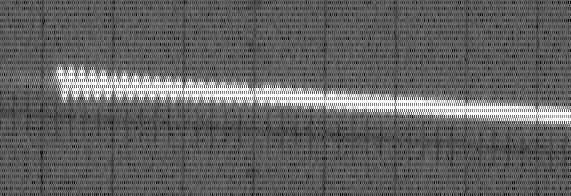This is getting a little far afield from my original reason for doing the testing, but yesterday’s mirror slap results got me interested in two things:
- Did the D4 work the same way as the D800E?
- How long did it take the mirror slap vibration to decay?
I put the D4 on the 400mm f/2.8 (choosing my words advisedly here) and repeated yesterday’s remote release test with no shutter delay and the oscilloscope time base set to 1/10 second per division:
Looks pretty similar, given the D4’s larger pixel pitch. The frequency of the vibration is about the same as with the D800E. I thought it might be lower given the D4’s increased mass.
To get an idea of how fast the vibrations die out, I changed the time base on the ‘scope to 1/2 second per division:
This looks like a classic second-order underdamped system. The sinusoid is amplitude modulated by a decaying exponential. The key thing to determine is the time at which the amplitude of he oscillations decay to 36.8% (1/e) of their original value. That is called the time constant of the system. If we know that, we can calculate the amplitude of the oscillation at any time, even though it’s too small to see with our big spot size.
My eyeballs say that the time constant of this trace is about 2 seconds (it could be 3). Two means that the vibration decays to 13.5% of its original value in 4 seconds, 5% or its original value in 6 seconds, and a little less than 2% of its starting value in 8 seconds. Three means that the vibration decays to 13.5% of its original value in 6 seconds, 5% or its original value in 9 seconds, and a little less than 2% of its starting value in 12 seconds.
Since the starting peak to peak value is about 11 pixels, with a time constant of two seconds it will take about five seconds to decay to one pixel, which means that a three second shutter delay is too short. Since three seconds is the longest shutter delay the D4 allows, the right way to deal with mirror slap with the D4/400mm f/2.8 is to use the “mirror up” setting, pressing the remote release once to raise the mirror, waiting five or six seconds, and pressing it again.
Assuming the D800E decay time constant is the same, since the D800E pixels are smaller, we’ll have to wait another time constant to let the vibration damp down to under one pixel peak to peak — that’s six or seven seconds at a time constant of 2, or 9 to 12 seconds at a time constant of three.


Leave a Reply